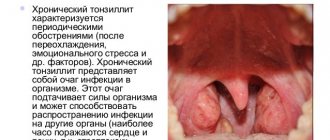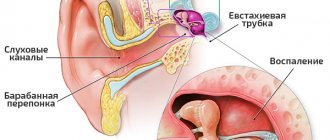According to the International Classification of Diseases 10, tonsillitis is divided into acute and chronic, which are distinguished as independent nosological forms with their own codes: J03, J35.0. They make it possible to simplify the activities of medical workers in registering patients.
Acute tonsillitis (ICD code 10 J03) or tonsillitis is an infectious disease during which the tonsils (palatine tonsils) become inflamed. It is contagious and transmitted through direct contact or food. Self-infection with microbes living in the throat also occurs. When immunity decreases, their activity increases.
Often the causative agent is streptococcus A (can be found in almost all healthy people and poses a threat to others), a little less often - adenoviruses, pneumo- and staphylococcus.
Therapy of the acute form consists of eliminating the pathogenic microorganism and generally alleviating the patient’s condition.
So, for what reasons does tonsillitis (tonsillitis) occur? ICD 10 codes are indicated.
What is ICD used for?
The ICD is used to systematize analyzes and compare data on population morbidity and mortality levels obtained in different countries and regions in different time periods.
The International Classification of Diseases is used to convert verbal statements of diseases and other medical issues into an alphanumeric code for easy storage, retrieval and further analysis.
The International Classification of Diseases is a standard procedure that helps to correctly analyze epidemiological risks and carry out the management process in medicine.
The classification allows you to analyze the general situation regarding the incidence of the population, calculate the spread of certain diseases and determine the relationship with various associated factors.
Acute tonsillitis ICD code J03
Throat diseases are common diseases among people of different age groups. Let's look at the most common ones.
J03.0 Streptococcal tonsillitis.
The more common name is tonsillitis. Caused by GABHS (group A beta-hemolytic streptococcus). Occurs with elevated temperature and severe intoxication of the body.
The lymph nodes become enlarged and become painful. The tonsils become loose and become covered with a whitish coating, partially or completely. For treatment, drugs of the penicillin group or macrolides are used.
J03.8 Acute tonsillitis.
Caused by other specified pathogens - caused by other pathogens, which include the herpes simplex virus. The disease proceeds according to the type of acute tonsillitis, code according to ICD 10. Treatment is selected based on the causative agent, which is determined in the laboratory.
J03.9 Acute tonsillitis, unspecified.
May be follicular, gangrenous, infectious or ulcerative. It occurs as an acute disease with high fever, rashes on the tonsils and severe sore throat. Treatment is complex, using antibiotics and local antiseptics.
Causes of acute tonsillitis
With the same type of sore throat in adults and children, the cause of the disease may differ. Therefore, acute tonsillitis is primarily classified according to the type of pathogen:
- Bacterial sore throat. This includes infections caused by streptococci and staphylococci.
- Viral etiology. This group includes pathogenic herpes microorganisms and adenoviruses.
- Mixed forms. There are pathologies caused by bacteria and viruses simultaneously.
- Fungal sore throat. Appears as a concomitant symptom of damage to other organs and further penetration of the fungus into the palatine tonsils.
- Parasitic tonsillitis. The causative agent is amoebas that enter the palatine tonsils from the oral cavity.
- Vincent's angina. The disease is caused by two pathogenic microorganisms: oral spirochete and spindle bacillus
The peak of diseases occurs in the winter months. They are most often infected by airborne droplets: through close contact with a carrier of the infection. Sore throat is also transmitted through personal hygiene items.
Acute tonsillitis: etiology of sore throat
Chronic diseases of the tonsils and adenoids ICD code J35
Chronic diseases of the tonsils and adenoids develop in the case of persistent colds, which are accompanied by sore throat.
An infectious-allergic disease, which manifests itself as persistent inflammation of the tonsils and is characterized by a chronic course, develops after infectious diseases or as a manifestation of allergies.
It occurs with enlargement and loosening of the tonsils, some of their parts are covered with purulent plaque. Antibacterial therapy and local sanitizing agents are used.
J35.1 Hypertrophy of the tonsils.
It is more often noted in children as a general lymphatic constitution. In hypertrophied tonsils, most often, inflammatory processes do not occur. Enlarged tonsils make it difficult to breathe and swallow food. The patient's speech is unintelligible and his breathing is noisy. Local astringents and cauterizing substances are used for therapy.
J35.2 Adenoid hypertrophy.
Pathological proliferation of the nasopharyngeal tonsils, which occurs due to hyperplasia of lymphoid tissues. The disease is often diagnosed in young children.
If there is no proper treatment, the adenoids quickly enlarge and make nasal breathing difficult. This condition causes associated diseases of the throat, ear, or nose. Treatment can be conservative using inhalations, hormones and homeopathic remedies, or surgical.
J35.3 Hypertrophy of the tonsils with hypertrophy of the adenoids.
Cases of simultaneous enlargement of the tonsils and adenoids in children are common, especially if there is a frequent history of infectious diseases. Comprehensive treatment is used, which contains topical preparations and medications to maintain immunity.
J35.8 Other chronic diseases of the tonsils and adenoids.
They arise due to frequent colds, which are accompanied by sore throats. The main treatment is aimed at restoring the immune system, using sanitizing drugs.
J35.9 Chronic disease of the tonsils and adenoids, unspecified.
Caused by pathogenic microorganisms that cause frequent sore throats presented in ICD 10, with the slightest cooling, and general intoxication of the body. Treatment boils down to washing the tonsils and using physiotherapeutic procedures. Therapy is carried out in courses at least twice a year.
All throat diseases that are accompanied by tonsillitis or other changes according to ICD 10 must be treated only under the supervision of a doctor. This will prevent possible complications and speed up the healing process.
Acute tonsillitis (tonsillitis) is a common infectious disease in which inflammation of the tonsils (tonsils) occurs. It is a contagious disease that is transmitted through airborne droplets, direct contact or food. Self-infection (autoinfection) with microbes that live in the pharynx is often noted. When immunity decreases, they become more active.
Microbial pathogens are often group A streptococcus, and slightly less commonly staphylococcus, pneumococcus and adenoviruses. Almost all healthy people can have streptococcus A, which poses a danger to others.
Acute tonsillitis, ICD 10 code of which is J03, if it occurs repeatedly, is dangerous for humans, so re-infection should be avoided and a sore throat should be completely cured.
ICD code xp tonsillitis – myLor
The increasing number of patients with chronic tonsillitis is the result of a lack of attention to one’s own health.
Doctors note that it is especially important not to stop the course of treatment for the acute form of the disease after some symptomatic relief. It is worth following all prescribed procedures and taking medications according to the regimen.
In the case of constantly recurring tonsillitis, the disease becomes chronic.
Chronic tonsillitis, ICD code J35.0, is characterized by exacerbation in winter or in the off-season.
The presence of a constant source of inflammation reduces immunity and increases the body's susceptibility to respiratory diseases.
In the absence of proper therapy or general weakening of the body, as a result of which irreversible processes begin in the tissues of the tonsils, surgical intervention may be indicated.
In case of chronic tonsillitis ICD 10, two types of sore throat can be considered. The compensated type is a disease in which the immune system helps to stop pathological processes, and the use of appropriate medications is effective. Decompensated chronic tonsillitis is a variant with constant exacerbations.
In this case, the immune system is not able to cope with the disease, and the tonsils lose their basic functions. This severe form often ends with tonsillectomy - removal of the tonsils. This classification helps to clarify the degree of damage to the protective organ.
Symptoms of chronic tonsillitis:
- Discomfort, soreness, some burning in the throat.
- Reflex coughing attacks, which are caused by irritation of the mucous membrane of the palate and larynx.
- Enlarged cervical lymph nodes. This symptom of tonsillitis is common in children and adolescents, but also occurs in adult patients.
- The elevated body temperature that accompanies the inflammatory process is not relieved by conventional means and can persist for a long time. In this case, doctors recommend visiting a doctor, even if the symptoms are somewhat blurred and do not seem acute.
- Headache, constant fatigue, muscle pain.
- Upon examination, the surface of the tonsils appears loose. The palatine arches are hyperemic. Upon examination, the doctor will detect the presence of purulent plugs that have an unpleasant odor.
Often the patient gets used to the altered state, resigns himself and does not take appropriate measures. The problem is sometimes discovered during preventive examinations.
The international classifier has identified this disease as an independent nosological unit, since it has a characteristic clinical and morphological picture.
Conservative treatment of chronic tonsillitis ICD code 10 includes:
- Taking antibiotics prescribed by an ENT specialist, taking into account the individual characteristics of each person.
- The use of antiseptics that sanitize lacunae and nearby surfaces. Chlorhexidine, Hexoral, Octenisept, and traditional Furacilin are usually used.
- An effective physical therapy supplement. Standard procedures allow tissue restoration, and innovative laser therapy will not only reduce inflammation, but also help strengthen the immune system. The technique combines direct laser action on the pharynx area and irradiation of the tonsils through the skin with infrared rays at a certain frequency.
During periods of remission, special attention should be paid to fortification, the formation of immune mechanisms using hardening, special drugs - for example, Imudon. Removal is resorted to only in the presence of constant, increasingly complex exacerbations that threaten serious complications.
Chronic inflammatory diseases of the pharyngeal and palatine tonsils are very common among both adults and children.
When preparing medical documentation, general practitioners and otorhinolaryngologists use the code for chronic tonsillitis according to ICD 10. The International Classification of Diseases, Tenth Revision, was created for the convenience of doctors around the world and is actively used in medical practice.
Acute and chronic diseases of the upper respiratory tract occur as a result of infection with pathogenic microorganisms and are accompanied by a number of unpleasant symptoms. If a child has adenoids, the risk of developing the disease increases due to difficulty breathing. Chr. Tonsillitis has the following symptoms:
- redness of the edges of the palatine arches;
- changes in tonsil tissue (thickening or loosening);
- purulent discharge in the lacunae;
- inflammation of regional lymph nodes.
With angina, which is an acute form of tonsillitis, the symptoms are more pronounced and the disease is more severe.
Delayed diagnosis of tonsillitis can lead to complications associated with other organs.
For effective treatment, it is necessary to identify and eliminate the cause of the pathological process, and also carry out antibacterial and anti-inflammatory therapy.
In ICD 10, chronic tonsillitis is coded J35.0 and belongs to the class of chronic diseases of the tonsils and adenoids.
Source: https://my-lor.ru/mkb-kod-hr-tonzillit/
Treatment of acute tonsillitis
Treatment of angina is aimed at local and general effects. General strengthening and hyposensitizing treatment and vitamin therapy are carried out. This disease does not require hospitalization, with the exception of severe cases.
Acute tonsillitis should be treated only under medical supervision. To combat diseases, the following measures are taken:
- If the disease is caused by bacteria, then antibiotics are prescribed: general and local. Sprays are used as local remedies, for example, Kameton, Miramistin, Bioparox. For resorption, lozenges with an antibacterial effect are prescribed: Lizobact, Hexalize and others.
- To relieve a sore throat, medications are prescribed that contain antiseptic components - Strepsils, Tantum Verde, Strepsils.
- Antipyretics are necessary for high temperatures.
- For rinsing, antiseptic and anti-inflammatory agents are used - Furacilin, Chlorhexilin, decoctions of medicinal herbs (sage, chamomile).
- Antihistamines are prescribed for severe swelling of the tonsils.
The patient is isolated and a gentle regime is prescribed. You need to follow a diet, do not eat hot, cold, spicy foods. Full recovery occurs in 10-14 days.
Chronic tonsillitis ICD 10 code, symptoms
Chronic tonsillitis can form as a result of a previous sore throat, that is, when inflammatory processes secretly continue to become chronic. However, there are cases when the disease appears without previous tonsillitis.
The main symptoms of the disease include:
- Headache
- Fast fatiguability
- General weakness, lethargy
- Fever
- Discomfort when swallowing
- Bad breath
- Sore throat that appears periodically
- Dry mouth
- Cough
- Frequent sore throats
- Enlarged and painful regional lymph nodes.
The symptoms are similar to those of acute tonsillitis, so similar treatment is prescribed.
With chronic tonsillitis, damage to the kidneys or heart often occurs, since toxic and infectious factors enter the internal organs from the tonsils.
Chronic tonsillitis according to ICD 10 – J35.0.
General symptoms of acute tonsillitis
Acute tonsillitis is characterized by the following main symptoms:
- temperature rise to forty degrees;
- feeling of a foreign object in the throat and soreness;
- acute pain in the throat, which intensifies during swallowing;
- headache;
- weakness;
- pain in joints and muscles;
- less often, pain in the heart may occur;
- the lymph nodes become inflamed, resulting in unpleasant sensations in the neck when turning the head.
Treatment of chronic tonsillitis
During the period of exacerbation of sore throat, the same measures are taken as in the acute form of the disease. The disease is fought as follows.
- Physiotherapeutic procedures for the restoration of tonsil tissue, accelerating their regeneration.
- Antiseptics (hydrogen peroxide, Chlorhexidine, Miramistin) for washing lacunae.
- To strengthen the immune system, vitamins, hardening, and Imudon are prescribed.
Removal of the tonsils (tonsillectomy) is performed if chronic tonsillitis occurs with frequent exacerbations.
Sore throat is one of the most common symptoms.
Let's consider a disease for which this symptom is very pronounced - lacunar tonsillitis (ICD code 10 J03).
Chronic tonsillitis - Review of information
Chronic tonsillitis is an active chronic inflammatory focus of infection in the palatine tonsils with periodic exacerbations with a general infectious-allergic reaction. The infectious-allergic reaction is caused by constant intoxication from the tonsillar source of infection and intensifies with exacerbation of the process. It disrupts the normal functioning of the entire body and aggravates the course of common diseases, often itself becoming the cause of many common diseases, such as rheumatism, diseases of the joints, kidneys, etc.
Chronic tonsillitis can rightfully be called a “disease of the 20th century” that has “successfully” crossed the line of the 21st century. and still constitute one of the main problems not only of otorhinolaryngology, but also of many other clinical disciplines, in the pathogenesis of which allergies, focal infections and deficient conditions of local and systemic immunity play a major role. However, the basic factor that is of particular importance in the occurrence of this disease, according to many authors, is the genetic regulation of the immune response of the palatine tonsils to the influence of specific antigens. On average, according to a survey of different population groups, in the USSR in the second quarter of the 20th century. the incidence of chronic tonsillitis fluctuated between 4-10%, and already in the third quarter of this century, from a report by I.B. Soldatov at the VII Congress of Otorhinolaryngologists of the USSR (Tbilisi, 1975), it followed that this figure, depending on the region of the country, increased to 15.8 -31.1%. According to V.R. Goffman et al. (1984), chronic tonsillitis affects 5-6% of adults and 10-12% of children.
ICD-10 code
J35.0 Chronic tonsillitis.
ICD-10 code J35.0 Chronic tonsillitis
Epidemiology of chronic tonsillitis
According to domestic and foreign authors, the prevalence of chronic tonsillitis among the population varies widely: in adults it ranges from 5-6 to 37%, in children from 15 to 63%. It is necessary to keep in mind that between exacerbations, as well as in the non-anginal form of chronic tonsillitis, the symptoms of the disease are largely familiar and little or do not bother the patient at all, which significantly underestimates the actual prevalence of the disease. Often chronic tonsillitis is detected only in connection with the examination of the patient for some other disease, in the development of which chronic tonsillitis plays a large role. In many cases, chronic tonsillitis, remaining unrecognized, has all the negative factors of tonsillar focal infection, weakens a person’s health, and worsens the quality of life.
Causes of chronic tonsillitis
The cause of chronic tonsillitis is a pathological transformation (development of chronic inflammation) of the physiological process of immunity formation in the tissue of the palatine tonsils, where the normally limited process of inflammation stimulates the production of antibodies.
The palatine tonsils are part of the immune system, which consists of three barriers: lympho-blood (bone marrow), lympho-interstitial (lymph nodes) and lympho-elithelial (lymphoid accumulations, including tonsils, in the mucous membrane of various organs: pharynx, larynx, trachea and bronchi, intestines). The mass of the palatine tonsils makes up a small part (about 0.01) of the lymphoid apparatus of the immune system.
Symptoms of chronic tonsillitis
One of the most reliable signs of chronic tonsillitis is the presence of tonsillitis in the anamnesis. In this case, it is necessary to find out from the patient what kind of increase in body temperature is accompanied by sore throat and for what period of time. Sore throats in chronic tonsillitis can be pronounced (severe sore throat when swallowing, significant hyperemia of the pharyngeal mucosa, with purulent attributes on the palatine tonsils according to the form, febrile body temperature, etc.), but in adults such classic symptoms of sore throat often do not occur. In such cases, exacerbations of chronic tonsillitis occur without pronounced severity of all symptoms: the temperature corresponds to low subfebrile values (37.2-37.4 C), the pain in the throat when swallowing is insignificant, and a moderate deterioration in general well-being is observed. The duration of the disease is usually 3-4 days.
Where does it hurt?
Sore throat Sore throat when swallowing
Screening
It is necessary to screen for chronic tonsillitis in patients with rheumatism, cardiovascular diseases, diseases of the joints, kidneys, it is also advisable to keep in mind that in case of general chronic diseases, the presence of chronic tonsillitis to one degree or another can activate these diseases as a chronic focal infection, therefore in In these cases, examination for chronic tonsillitis is also necessary.\
Diagnosis of chronic tonsillitis
The diagnosis of chronic tonsillitis is established on the basis of subjective and objective signs of the disease.
The toxic-allergic form is always accompanied by regional lymphadenitis - enlarged lymph nodes at the angles of the lower jaw and in front of the sternocleidomastoid muscle. Along with determining the enlargement of the lymph nodes, it is necessary to note their soreness on palpation, the presence of which indicates their involvement in the toxic-allergic process. Of course, for a clinical assessment it is necessary to exclude other foci of infection in this region (teeth, gums, sinuses, etc.).
What needs to be examined?
Tonsils Palatine tonsil
What tests are needed?
Antistreptolysin O in the blood serum Antibodies to streptococci A, B, C, D, F, G in the blood Staphylococcal infections: antibodies to staphylococci in the blood serum
Who to contact?
ENT - doctor Otolaryngologist
Treatment of chronic tonsillitis
In case of a simple form of the disease, conservative treatment is carried out in 10-day courses for 1-2 years. In cases where, according to the assessment of local symptoms, the effectiveness is insufficient or an exacerbation (angina) has occurred, a decision may be made to repeat the course of treatment. However, the absence of convincing signs of improvement, and especially the occurrence of repeated sore throats, is considered an indication for removal of the tonsils.
In the toxic-allergic form of degree I, it is still possible to carry out conservative treatment of chronic tonsillitis, however, the activity of the chronic tonsillar source of infection is already obvious, and general severe complications are likely at any time. In this regard, conservative treatment for this form of chronic tonsillitis should not be prolonged unless significant improvement is observed. The toxic-allergic form of the II degree of chronic tonsillitis is dangerous with rapid progression and irreversible consequences.
More information about treatment
Tonsillitis: treatment Antibiotics for tonsillitis Removal of tonsils (tonsillectomy) Physiotherapy for sore throat Antibiotics for sore throat Antibiotics for sore throat in children How to treat?
Tsebopim ilive.com.ua
Types of sore throats
There are several types of sore throat:
- Catarrhal . It is characterized by superficial damage to the tonsils, the presence of a purulent mucous film and slight hyperemia.
- Follicular . The enlargement of the tonsils is clearly visible. Yellowish purulent dots form on their surface.
- Lacunar . A more severe manifestation of follicular tonsillitis. Yellow dots merge into an extensive plaque and close the cavity of the lacunae.
Fibrinous, herpetic and phlegmonous forms are less common.
Causes of lacunar form
The tonsils in the oral cavity perform a very important function. They work as a purifying filter, absorbing and neutralizing pathogenic microorganisms that should not enter the human body further.
When the immune system is weakened, they are not able to fully protect against foreign bacteria, which begin to accumulate in the gaps and cause an inflammatory process. Very often, the lacunar form occurs in children, since their immune system is not yet perfect.
Most often, the causative agents of the disease are viruses, fungi, staphylococci and streptococci.
Predisposing factors for the accumulation of bacteria and the onset of the pathological process are:
- Hypothermia.
- Exhaustion and overload of the body (physical and psycho-emotional).
- Associated chronic diseases, especially in the surrounding areas (sinuses, nasal passages and oral cavity).
- Incorrect treatment of the initial stages of inflammation.
- Dental diseases.
- Injuries to the tonsils.
Causes
For effective treatment, it is extremely important to make the correct diagnosis. To determine the etiological factor, consult your doctor. What are the causes of sore throat? The most common types of microbes that cause sore throat are group A streptococci and staphylococci. In the ICD 10 classification of diseases, acute inflammation of the tonsils is designated by the code J03.0 - streptococcal tonsillitis, J03.8 - acute tonsillitis caused by other specified pathogens, J03.9 - acute unspecified tonsillitis3.
Among other causes of acute tonsillitis there are: other bacteria, fungi, viruses, protozoa, and in severe cases their associations: fungal-bacterial, viral-bacterial. Other pathogens are less common: for example, anaerobic microorganisms, chlamydia, mycoplasma, as well as representatives of the normal microflora of the oral cavity, which, when the immune system is weakened, can cause acute bacterial tonsillitis.
In the pathogenesis (the path of disease development) of acute tonsillitis, the state of the body, its resistance to external factors, the presence of foci of chronic infection of the oral cavity, and difficulty in nasal breathing (especially often in children) also play a role. The process of inflammation can also be triggered by a lack of vitamin C, B vitamins, stress, or a sudden change in climate.
Symptoms of acute tonsillitis vary depending on the type of sore throat. Let's consider the clinical manifestations of its most common forms:
- Catarrhal sore throat: Its first characteristic symptom is a painful sensation in the throat. Also, in most cases, there is a feeling of a foreign body, pain when swallowing, hoarseness, and a “sore” or “sore” sensation in the throat. The general condition remains satisfactory, but there is a headache and general malaise. During pharyngoscopy (examination of the pharynx), the doctor sees redness of the tonsils, they are swollen, their vessels are injected. The patient's temperature reaction is not expressed (up to 38 degrees) or remains normal. In the general blood test, the changes are not significant (slight leukocytosis, ESR 15-20 mm/h). Catarrhal tonsillitis with proper treatment is mild and resolves after 3–5 days without complications.
- With follicular angina, the patient's condition is moderate; light yellow spots - small pustules - can be seen on the mucous membrane of the tonsils, and there is a characteristic odor from the mouth. Fever in acute follicular tonsillitis reaches febrile levels (more than 38 degrees). Significant changes in the blood (leukocytosis with a shift to the left, a pronounced increase in ESR, increased levels of acute-phase proteins). Intoxication of the body increases (intense headache, myalgia, arthralgia). The pain in the throat becomes stronger and can radiate to the ear and neck. Local lymph nodes are painful and enlarged. Children may experience vomiting and convulsions due to high fever. This condition is dangerous and requires prompt hospitalization.
- Lacunar tonsillitis is the next stage of the process. The symptoms are similar to those of follicular tonsillitis, but more pronounced. When examining the pharynx, a yellow-gray coating is visible in the crypts (recesses) of the tonsils, which does not extend beyond the palatine arches. Foci of necrosis (dead tissue) are visible.
Good to know:
In children, due to the anatomical features of the body, namely: loose tissue rich in blood vessels, funnel-shaped larynx, and symptoms of tonsillitis, a dangerous complication can quickly develop. Against the background of a sore throat, difficulty swallowing, swelling increases and the lumen of the larynx narrows significantly. This emergency condition is called croup and requires immediate medical intervention (tracheostomy).
Diagnosis of acute tonsillitis.
To clarify the diagnosis and prescribe treatment, consult a specialist. The diagnosis of tonsillitis can be made by a doctor based on anamnesis, complaints, examination data, and clinical picture.
Laboratory studies include bacteriological (detection of the growth of pathogenic flora in biomaterials from the oropharynx, for example, group A β-hemolytic streptococcus) and serological (determination of antibodies to streptococcal antigens in the blood serum or other media being tested).
There will also be changes in the patient’s blood (leukocytosis, increased ESR, in more severe cases anemia, thrombocytopenia); protein and red blood cells may be detected in the urine if the kidneys are damaged.
If there are plaques on the tonsils, diphtheria should be excluded, especially in unvaccinated individuals. The plaque of diphtheria is characteristic: it is dense, dirty white or yellow, and appears by the second day of illness. The film cannot be rubbed with a spatula; it requires effort to remove it; if you lower the film into a vessel with liquid, it will sink.
Body temperature during diphtheria is often subfebrile (no more than 38 degrees), which does not correspond to the severity of the condition, which progressively worsens. Muscle pain, general weakness, and difficulty breathing appear.
The diagnosis is also confirmed by bacteriological examination of samples taken from the tonsils. The test material is placed on a nutrient medium. With this method, diphtheria bacilli can be detected in 80% of cases.
Differential diagnosis of acute tonsillitis is carried out with the aim of carrying out etiotropic therapy (impact on the cause of the disease). With scarlet fever and measles, tonsillitis will be accompanied by the appearance of a rash; the epidemiological history is also characteristic; children are mainly affected. With infectious mononucleosis, a distinctive feature will be changes in the blood test: namely, the presence of atypical mononuclear cells, with agranulocytic tonsillitis - a decrease in leukocytes and granulocytes in the blood, and with leukemia - the presence of blast cells.









